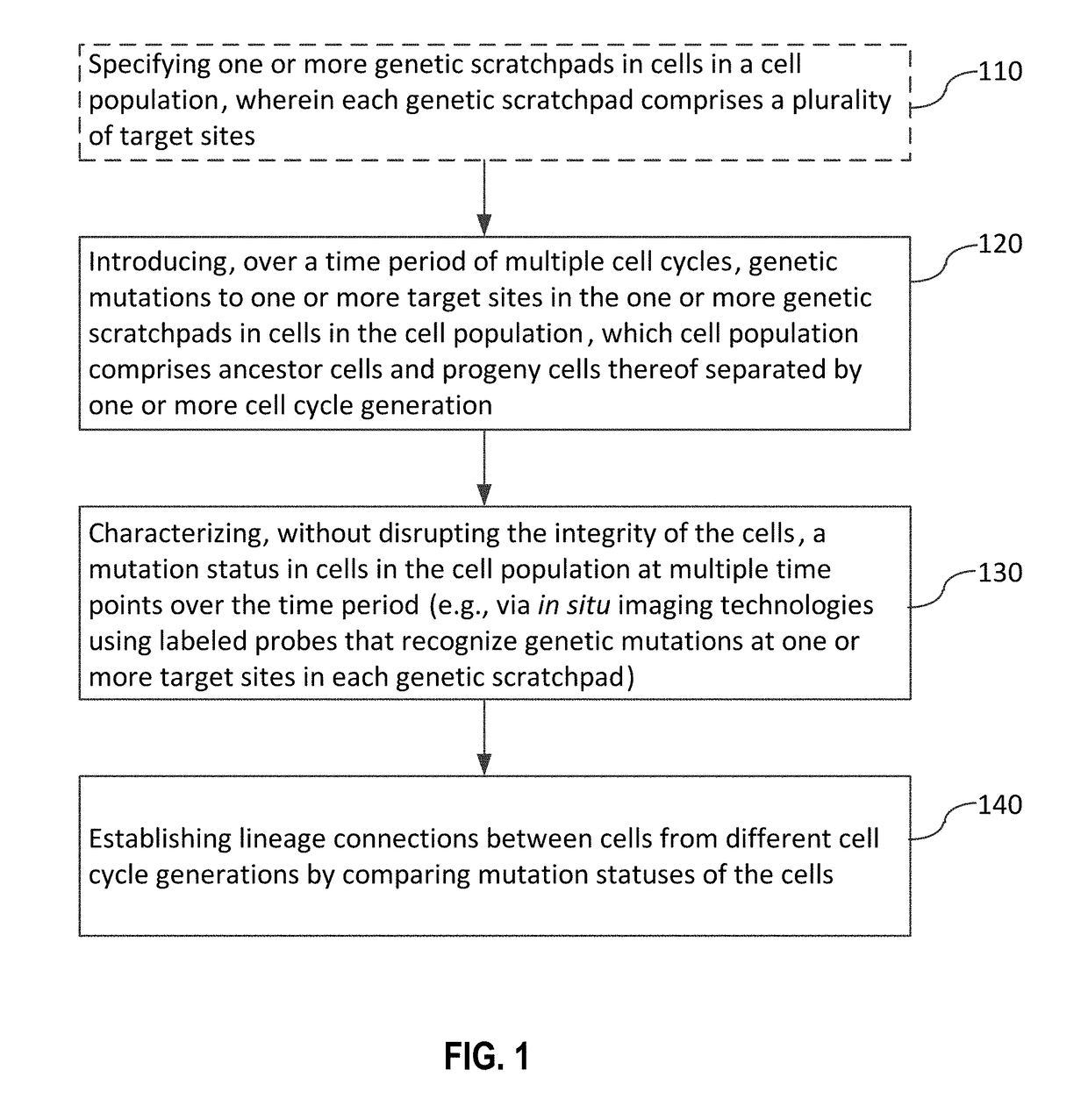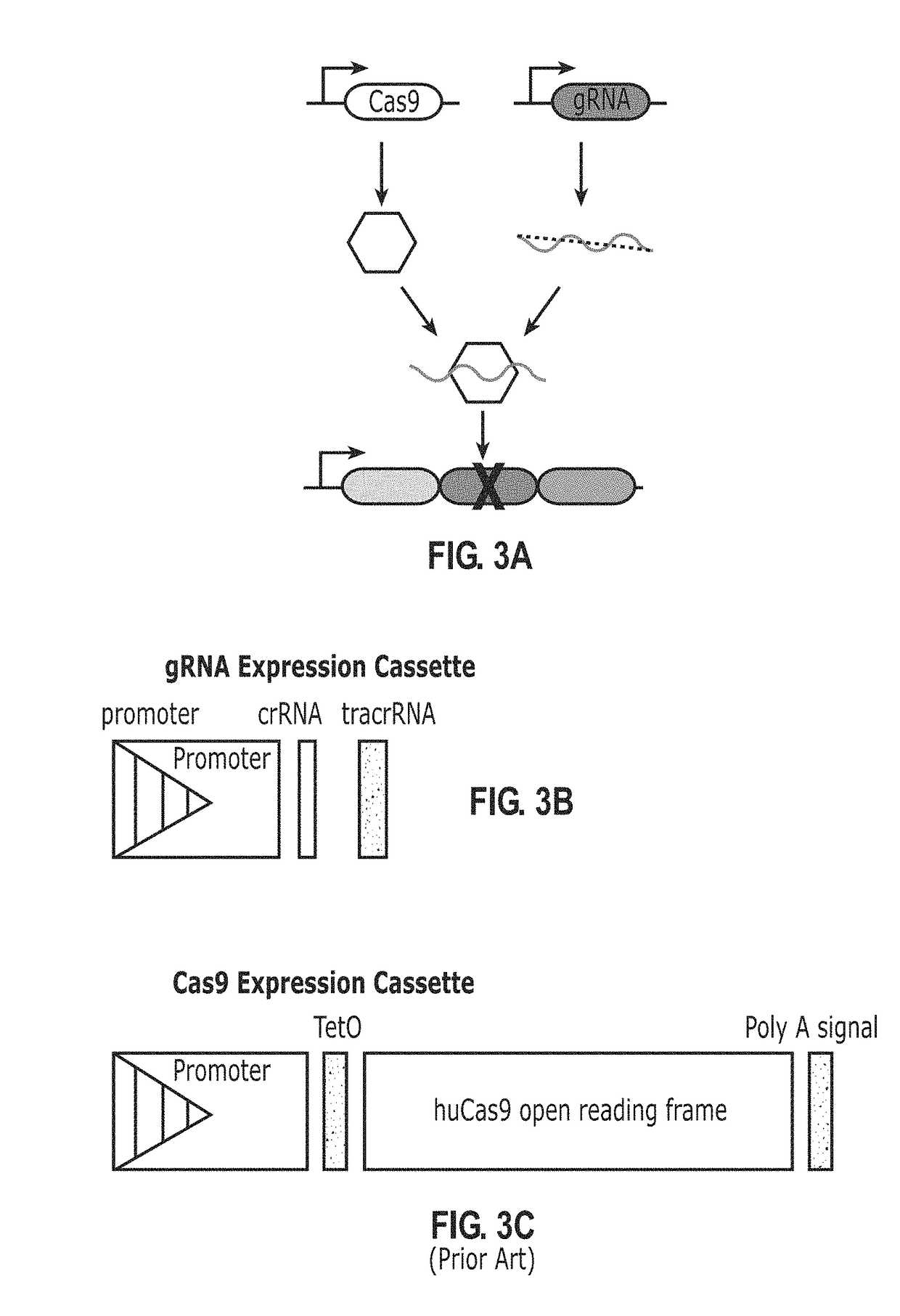Recording and mapping lineage information and molecular events in individual cells
a technology of molecular events and lineage information, applied in the field of individual cell lineage information and molecular events recording and mapping, can solve the problems of inability to follow multiple lineage decisions or reconstruct an entire tree, systemic techniques that can produce such comprehensive maps in more complex organisms are lacking, and existing lineage determination approaches have severe limitations
- Summary
- Abstract
- Description
- Claims
- Application Information
AI Technical Summary
Benefits of technology
Problems solved by technology
Method used
Image
Examples
example 1
Materials and Methods
[0222]Recording system component construction. The scratchpad transposon was constructed from a ten-repeat array (20× PP7 stem loops) derived from plasmid pCR4-24×PP7SL and ligated directionally using BamH1 and BglII sites into a modified form of the PiggyBac (PB) vector PB510B (SBI) lacking the 3′ insulator and including a multiple cloning site (MCS). The CMV promoter was then removed using NheI and SpeI and replaced by a PGK promoter with Gibson assembly. A gBlock (IDT) containing the AvrII and XhoI restriction sites, priming sequences, and the BGH polyA was then introduced 3′ of the PP7 array by Gibson assembly using the EagI site in the backbone. Unique barcodes were then inserted into the transposon in the region 3′ of the scratchpad array either by Gibson assembly or directed ligation using AvrII and XhoI. A total of 28 unique barcode sequences (GenScript Biotech) derived from Saccharomyces cerevisiae were used to generate the barcoded scratchpads. Scratch...
example 2
Exemplary Scratchpad
[0239]Using a system illustrated in FIG. 7, the state of this scratchpad can be stochastically altered in live cells and read out in situ in single cells by smFISH. In this example, the scratchpad element consisted of 10 repeat units. gRNA targeting of Cas9 to the scratchpad generated double-strand breaks that result in its deletion, cut or ‘collapse’. (see e.g., FIGS. 7C and 7D, 8A, 8B, 17A, 17F). Adjacent to each scratchpad, a co-transcribed barcode was incorporated. The barcode and scratchpad components was each be identified using specific sets of smFISH probes, and thus served as an addressable ‘bit’.
[0240]Using a pool of such barcoded scratchpads enables lineage recording and readout through a two-step process. During cell proliferation, Cas9 generates gradual and stochastic accumulation of collapsed scratchpads in each cell lineage. Subsequently, cells can be fixed and analyzed by seqFISH to identify barcodes and assess their states based on the presence o...
example 3
CRISPR System Deletes Portions of Genetic Scratchpads
[0245]FIGS. 8A and 8B demonstrate that the CRISPR system can write on a genetic scratchpad and results in deletions of portions of sequences of the scratchpad.
[0246]FIG. 8A shows the result of bulk PCR of scratchpad in mammalian cells. Scratchpad remains intact in the absence of both gRNA and Cas9, but can be deleted when Cas9 and gRNA are both expressed. A band representing cut scratchpads is clearly visible when both gRNA and Cas9 are present, but absent when either component is missing.
[0247]FIG. 8B shows the results of individual yeast clones analysis. Here, efficient removal by the CRISPR system of most repeats of a repetitive scratchpad core is clearly observed, as indicated by multiple bands corresponding to loss of repetitive sequences from a scratchpad core. This writing approach is applicable in many organisms, including mammalian and yeast cells.
PUM
| Property | Measurement | Unit |
|---|---|---|
| Length | aaaaa | aaaaa |
| Time | aaaaa | aaaaa |
Abstract
Description
Claims
Application Information
 Login to View More
Login to View More - R&D
- Intellectual Property
- Life Sciences
- Materials
- Tech Scout
- Unparalleled Data Quality
- Higher Quality Content
- 60% Fewer Hallucinations
Browse by: Latest US Patents, China's latest patents, Technical Efficacy Thesaurus, Application Domain, Technology Topic, Popular Technical Reports.
© 2025 PatSnap. All rights reserved.Legal|Privacy policy|Modern Slavery Act Transparency Statement|Sitemap|About US| Contact US: help@patsnap.com



